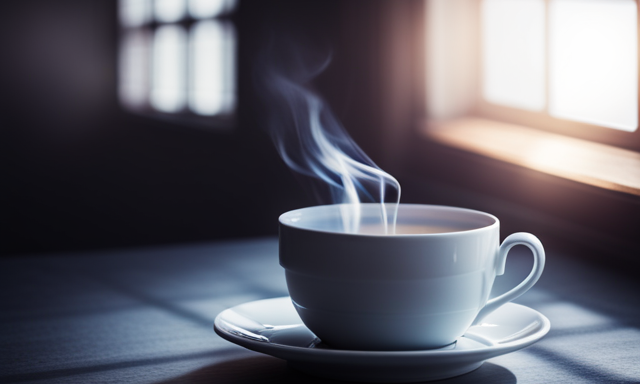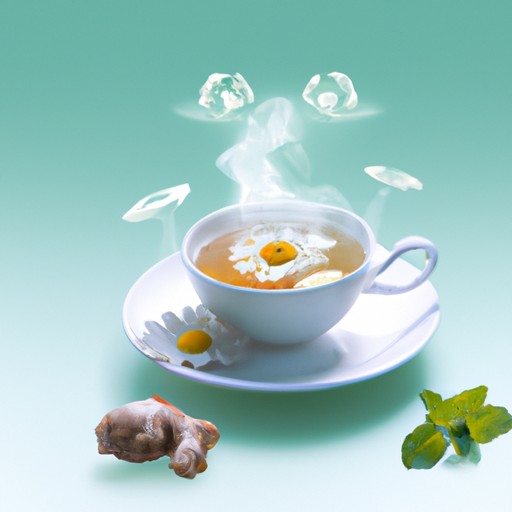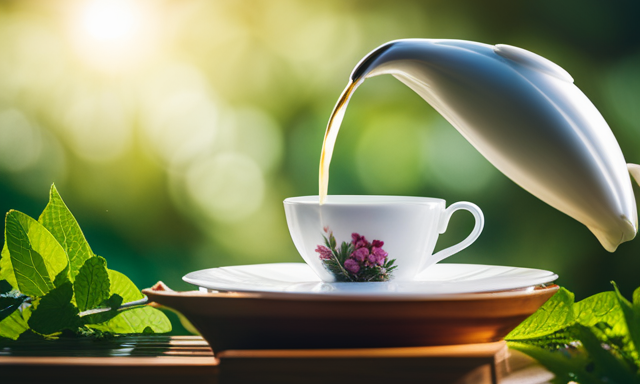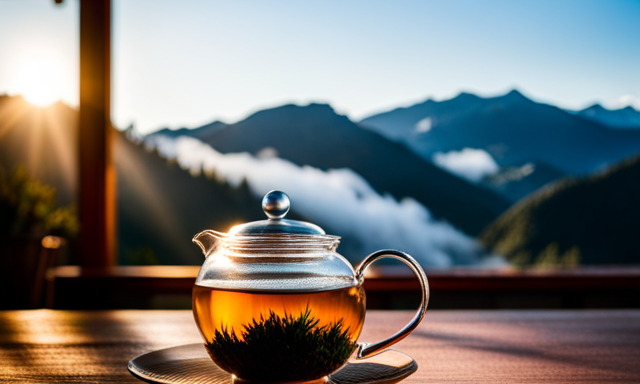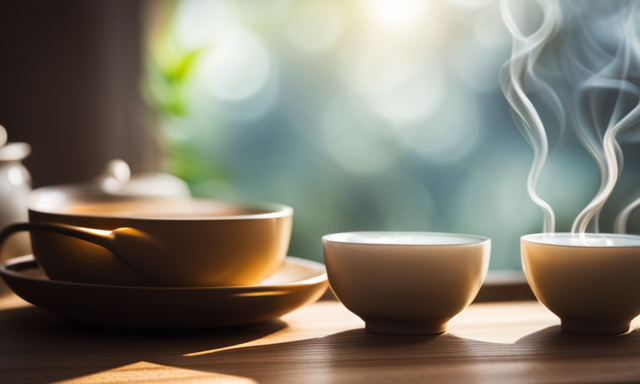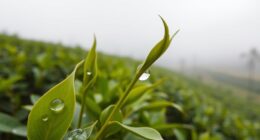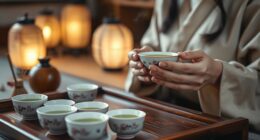As I sit here, sipping on a warm cup of oolong tea, I am transported to a world of exquisite flavors and centuries-old traditions. Oolong tea, with its unique balance of aroma and taste, is a beverage that captivates the senses and delights the palate.
In this article, we will explore the wonders of oolong tea, from its origins and production process to its diverse flavors and health benefits. We will delve into the art of brewing oolong tea and its significance in Chinese tea culture.
We will also discover how this remarkable tea has made its way across the globe, gaining popularity among tea connoisseurs worldwide. Whether you are a seasoned tea lover or new to the world of oolong, join me on this journey as we uncover the secrets of this remarkable beverage and learn how to truly appreciate its nuances.
Key Takeaways
- Oolong tea has a distinctive flavor and aroma, with delicate and floral, rich and roasted, or complex and fruity taste profiles.
- Oolong tea offers numerous health benefits, including aiding in weight loss, improving cardiovascular health, and containing antioxidants called catechins.
- Brewing techniques and choice of teaware can enhance the oolong tea drinking experience, and multiple infusions can reveal new layers of flavor.
- Oolong tea is deeply rooted in Chinese tea culture and traditions, with tea ceremonies, appreciation, and artistry playing significant roles.
Origins of Oolong Tea
If you’re wondering where oolong tea comes from, you’ll be amazed to learn about its rich and fascinating origins.
Oolong tea, also known as Wu Long tea, has its roots in China, specifically in the Fujian and Guangdong provinces. The production techniques used to create this unique tea are highly specialized and require skilled artisans.
Oolong tea holds immense cultural significance in Chinese history and traditions. It is often associated with elegance and sophistication, and is even considered a symbol of good fortune.
The intricate process of producing oolong tea involves withering the leaves under the sun, allowing oxidation, and then stopping the oxidation process at specific stages. This careful manipulation of the tea leaves results in its distinctive flavor and aroma.
Transitioning into the subsequent section about the production process of oolong tea, it’s fascinating to delve deeper into the steps involved in creating this exceptional beverage.
Production Process of Oolong Tea
During the production process of oolong tea, one fascinating statistic is that the leaves are typically harvested when they are still young and tender. This is because young leaves are known to have a higher concentration of flavor compounds.
The production techniques for oolong tea involve a careful balance of oxidation and fermentation. After harvesting, the leaves are spread out in the sun to wither and then shaken to bruise the edges, which activates the oxidation process. The leaves are then allowed to partially oxidize before being heated to stop the oxidation process. This combination of oxidation and fermentation gives oolong tea its unique flavor profile.
The tea processing also involves rolling the leaves into tight balls or twisting them into long strands. These techniques help to release the aromatic compounds and enhance the flavors of oolong tea.
Moving on to the flavors of oolong tea, it is important to note that each variety offers a distinct taste experience.
Flavors of Oolong Tea
Get ready to embark on a flavorful journey as we explore the various taste profiles of oolong tea. This unique tea offers a delightful combination of floral notes and roasted flavors, creating a harmonious balance that is truly captivating. Here are three distinct taste profiles that oolong tea can exhibit:
-
Delicate and Floral: Some oolong teas have a gentle and fragrant aroma, reminiscent of blooming flowers. These teas often have a light and refreshing taste with subtle hints of orchid or lilac.
-
Rich and Roasted: Other oolong teas undergo a longer roasting process, resulting in a deeper and more robust flavor. These teas may have a toasted or nutty undertone, providing a satisfying and comforting experience.
-
Complex and Fruity: Some oolong teas have a complex flavor profile, featuring fruity notes such as peach or apricot. These teas offer a delightful combination of sweetness and tanginess, leaving a lingering and enjoyable aftertaste.
As we dive into the health benefits of oolong tea, prepare to discover how this incredible beverage can enhance your well-being.
Health Benefits of Oolong Tea
Let’s explore the amazing ways oolong tea can boost your health and well-being!
Oolong tea has been found to be effective in aiding weight loss. It contains antioxidants called catechins that can help boost metabolism and increase fat oxidation. By incorporating oolong tea into your daily routine, you may experience an improvement in your body’s ability to burn calories and shed those extra pounds.
Additionally, oolong tea has been linked to heart health benefits. Studies have shown that regularly consuming oolong tea can help reduce the risk of heart disease by improving cardiovascular health and lowering cholesterol levels.
With its numerous health benefits, oolong tea is truly a remarkable beverage.
Now, let’s move on to the next section and discover the perfect brewing techniques for oolong tea.
Brewing Techniques for Oolong Tea
When brewing oolong tea, it is important to consider the water temperature and steeping time. Using water that is too hot or steeping for too long can result in a bitter taste.
The choice of teaware and infusion methods can also enhance the overall experience of brewing oolong tea. Different teapots and brewing techniques can bring out unique flavors and aromas.
Oolong tea is known for its ability to be steeped multiple times. Each infusion offers a different flavor profile, allowing for a journey of taste exploration and the opportunity to savor the various layers of complexity in the tea.
Water Temperature and Steeping Time
To achieve the perfect steep for your oolong tea, make sure you’re using water that is just below boiling and let it steep for about 2-3 minutes. The water temperature is crucial in bringing out the best flavors and aromas in your oolong tea.
Here are some steeping techniques to enhance your tea experience:
- Start by heating the water to around 185-205°F (85-96°C).
- Pour the hot water into the teapot or cup, covering the leaves completely.
- Allow the tea to steep for 2-3 minutes, releasing its delicate flavors.
- Take a moment to appreciate the aroma as it unfolds.
- Finally, strain the tea leaves and pour the beautifully infused oolong tea into your teacup.
Now that you’ve mastered the water temperature and steeping time, let’s move on to exploring teaware and infusion methods to further enhance your oolong tea enjoyment.
Teaware and Infusion Methods
Enhancing your oolong tea experience involves exploring teaware and infusion methods, which can transport you to a world of sensory delight.
To ensure the best flavor and aroma, it is important to properly maintain your teaware. Clean your teapot, cups, and other brewing equipment regularly, using warm water and mild detergent. Avoid using harsh chemicals that can leave residue and affect the taste of your tea.
When it comes to infusion methods, there are various options available. Some people prefer using a gaiwan, a traditional Chinese teapot, while others opt for a clay teapot or a glass teapot to observe the tea leaves unfurl. Experiment with different methods to find the one that suits your taste.
Now, let’s move on to the next section and explore the exciting world of multiple infusions for flavor variations.
Multiple Infusions for Flavor Variations
Little did we know that unleashing the power of multiple infusions would unleash a symphony of flavors that would make our taste buds sing. When it comes to oolong tea, the possibilities are endless. Here are three reasons why multiple infusions can bring out the best in this exquisite tea:
-
Unfolding Complexity: Each infusion reveals a new layer of flavor, as the leaves slowly unfurl and release their essence. From the delicate floral notes in the first infusion to the rich, honey-like sweetness in the third, every sip is a journey of discovery.
-
Intensifying Aromas: With each subsequent infusion, the aroma becomes more pronounced and captivating. The room fills with the fragrance of orchids, roasted nuts, and even hints of caramel, creating an immersive tea-drinking experience.
-
Evolving Taste: As the leaves continue to steep, the taste evolves, offering a dynamic range of flavors. From a mellow and smooth start to a complex and lingering finish, each cup tells a story of oolong tea’s remarkable versatility.
Now, let’s dive into the fascinating world of oolong tea varieties and grades.
Oolong Tea Varieties and Grades
Oolong tea varieties and grades bring a delightful complexity and richness to the tea-drinking experience.
There are several different grades of oolong tea, each with its own unique flavor profile. The grades range from light and floral to dark and robust.
For example, a lightly oxidized oolong tea, such as a green oolong, will have a fresh and grassy flavor with hints of floral notes. On the other hand, a heavily oxidized oolong tea, like a dark oolong, will have a bold and earthy flavor with notes of roasted nuts and caramel.
The different grades and flavor profiles of oolong tea allow for a wide range of taste experiences.
Transitioning into the subsequent section about oolong tea and Chinese tea culture, these distinct varieties and flavors play a significant role in the rich traditions and customs of Chinese tea culture.
Oolong Tea and Chinese Tea Culture
When it comes to oolong tea and Chinese tea culture, there are three key points to explore.
First, tea ceremonies and traditions play a significant role in Chinese culture, with specific rituals and etiquette followed during tea preparation and serving.
Second, tea appreciation and artistry are highly valued, with tea masters showcasing their skills in tea making and presentation.
Lastly, Chinese medicine recognizes the health benefits of tea, with oolong tea being praised for its potential to promote overall well-being.
Tea Ceremonies and Traditions
Tea ceremonies and traditions bring an air of elegance to the enjoyment of oolong tea. In Chinese culture, tea ceremonies are seen as a form of art and a way to connect with nature and oneself. The ceremonies are often performed in designated tea rooms, where every aspect is carefully considered, from the choice of tea leaves to the arrangement of the tea set.
One sub-list of tea ceremonies includes the preparation rituals. This involves heating the teapot and cups, measuring the tea leaves, and pouring hot water over them in a specific manner. Another sub-list is the serving rituals, where the tea is poured into small cups and presented to guests with a graceful gesture. These rituals not only enhance the taste of the tea but also create a sense of tranquility and mindfulness.
Tea ceremonies and traditions are just the beginning of the journey into the world of oolong tea. The next section will delve into the artistry and appreciation of this exquisite beverage.
Tea Appreciation and Artistry
Immerse yourself in the world of tea appreciation and artistry, where every sip becomes a brushstroke on the canvas of your taste buds. Tea appreciation is a practice that allows you to fully engage your senses and experience the beauty of tea. It involves not only the taste, but also the aroma, color, and texture of the tea. Tea artistry, on the other hand, is the creative expression of tea through various methods such as tea ceremonies, tea brewing techniques, and tea ware design. It is a way to showcase the elegance and sophistication of tea. To give you a glimpse into the world of tea artistry, here is a table that showcases different tea ware and their unique characteristics:
| Tea Ware | Characteristics |
|---|---|
| Yixing Teapot | Enhances the flavor of tea over time due to its porous clay |
| Gongfu Tea Set | Allows for precise control of steeping time and temperature |
| Glass Teacup | Showcases the color and clarity of the tea |
| Bamboo Tea Tray | Provides a serene and natural setting for tea brewing |
| Tea Scoop | Used to measure and transfer tea leaves with precision |
As we delve into the world of tea and health in Chinese medicine, we will explore the therapeutic properties of oolong tea and its role in promoting well-being.
Tea and Health in Chinese Medicine
Tea appreciation and artistry have allowed me to delve into the world of tea and discover not only its exquisite flavors, but also its numerous health benefits. In Chinese medicine, tea is considered a powerful tool for promoting both physical and mental well-being.
One of the most fascinating aspects of tea is its connection to meditation. The act of preparing and drinking tea can be a deeply meditative experience, allowing one to slow down, focus on the present moment, and find inner peace.
Additionally, tea has been used in skincare for centuries. Its antioxidant and anti-inflammatory properties make it a popular ingredient in beauty products, helping to nourish and rejuvenate the skin.
As I explore the diverse world of tea, I am amazed by its versatility and the many ways it can enhance our lives.
Now, let’s delve into the enchanting realm of oolong tea around the world.
Oolong Tea Around the World
When it comes to oolong tea, one cannot ignore Taiwan and its famous oolongs. Taiwan is known for producing some of the finest oolong teas in the world, with its unique climate and lush mountainous regions providing the perfect conditions for tea cultivation.
China, with its rich oolong heritage, is another important player in the oolong tea scene. With a history dating back thousands of years, China has perfected the art of oolong tea production, offering a wide range of flavors and aromas.
Additionally, oolong tea has also made its way to Japan and other countries, with each region adding its own unique twist to this beloved beverage.
Taiwan and Its Famous Oolongs
Taiwan’s famous oolongs, with their unique flavors and aromas, have captivated tea enthusiasts worldwide. Taiwanese tea culture is deeply rooted in the art of oolong production, and the island is renowned for its high-quality teas.
The climate and soil conditions in Taiwan, particularly in the mountainous regions, contribute to the distinct flavors that are characteristic of Taiwanese oolongs. From the floral and creamy notes of Jin Xuan to the rich and roasted flavors of Dong Ding, each oolong variety showcases the expertise and dedication of Taiwanese tea farmers.
These teas are carefully crafted through traditional methods, including withering, rolling, and roasting, resulting in a complex and nuanced cup of tea.
As we delve into China’s rich oolong heritage, we will discover even more fascinating aspects of this beloved beverage.
China’s Rich Oolong Heritage
Moving on from Taiwan’s famous Oolongs, let’s dive into China’s rich Oolong heritage. China has a long and storied history when it comes to tea, and Oolong is no exception. Tea cultivation in China dates back thousands of years, and it has played a significant role in their culture and traditions. The country’s diverse climate and geography provide the perfect conditions for growing high-quality tea. From the misty mountains of Fujian province to the rocky cliffs of Wuyi, China offers a wide variety of Oolongs with distinct flavors and aromas. The intricate process of harvesting and processing these teas has been refined over centuries, resulting in the exquisite Oolong teas we enjoy today. Now, let’s explore how Oolong tea has made its way to Japan and other countries.
Oolong Tea in Japan and Other Countries
Japan and other countries have also embraced the rich flavors and aromas of China’s exquisite Oolong teas, expanding the global appreciation for this ancient beverage.
Oolong tea’s popularity in the United States has been steadily rising, as more people discover its unique taste and health benefits.
In Japan, while green tea still reigns supreme, oolong tea has carved out its own niche. Known for its balance between the grassy freshness of green tea and the deep richness of black tea, oolong tea offers a complex and satisfying flavor profile.
Whether it’s the delicate floral notes of a lightly oxidized oolong or the robust earthiness of a heavily roasted variety, oolong tea provides a versatile and enjoyable drinking experience.
Transitioning into the next section, pairing oolong tea with food enhances the overall dining experience.
Pairing Oolong Tea with Food
When it comes to pairing oolong tea with food, the perfect combination of flavors can elevate your dining experience to a whole new level. Oolong tea is incredibly versatile and pairs well with a variety of foods.
For those who enjoy grilled meats, oolong tea can be the perfect accompaniment. Its rich and robust flavor complements the smoky and savory notes of grilled meats, creating a harmonious balance.
Additionally, oolong tea can also be paired with desserts. Its slightly sweet and floral undertones provide a delightful contrast to the rich and decadent flavors of desserts, making it a refreshing choice.
Whether you’re enjoying a hearty meal or indulging in a sweet treat, oolong tea is sure to enhance your dining experience.
Speaking of enhancing, let’s move on to some tips for buying and storing oolong tea.
Tips for Buying and Storing Oolong Tea
When it comes to enjoying a cup of Oolong tea, pairing it with the right food can enhance the overall experience. However, before you can indulge in this delightful combination, it’s important to know some tips for buying and storing Oolong tea.
Buying Tips:
- Look for reputable tea vendors who source their Oolong tea from trusted regions known for producing high-quality leaves.
- Consider the type of Oolong tea you prefer, as there are different varieties with distinct flavor profiles.
- Pay attention to the freshness of the tea leaves and opt for loose leaf Oolong tea for a more authentic experience.
Storage Tips:
- Store Oolong tea in airtight containers away from moisture, light, and strong odors to preserve its freshness and flavor.
- Keep the tea away from heat sources and avoid exposing it to extreme temperatures.
- Use opaque containers or keep the tea in a dark and cool place to protect it from light degradation.
By following these buying and storage tips, you can ensure that your Oolong tea remains delicious and satisfying, ready to be paired with your favorite food.
Frequently Asked Questions
How do I know if the oolong tea I’m buying is of high quality?
When it comes to determining the quality of oolong tea, one must pay close attention to tea grading. It’s like reading a book, where the grade determines how captivating and satisfying the story will be.
Can I drink oolong tea if I have a caffeine sensitivity?
If you have caffeine sensitivity, there are alternatives to oolong tea. However, you can still enjoy the benefits of caffeine-free oolong tea, which offers a rich, flavorful taste without the stimulating effects of caffeine.
Does oolong tea have any side effects?
Drinking oolong tea can be a delightful experience, like sipping on a fragrant garden. However, it’s important to be aware of potential risks and interactions with medications. Let’s explore the side effects together.
How long should I steep oolong tea for the best flavor?
For the best flavor profiles, steeping oolong tea should be done for about 3-5 minutes. This allows the leaves to release their complex flavors, resulting in a rich and aromatic brew that is both smooth and balanced.
Can oolong tea help with weight loss?
Oolong tea can aid in weight loss due to its metabolism-boosting properties. Scientific studies have shown that oolong tea increases fat oxidation and promotes weight loss. So, incorporate oolong tea into your diet for effective weight management.
Conclusion
In conclusion, Oolong tea is a fascinating and versatile beverage that offers a unique taste experience.
With its origins in China and a production process that combines elements of both green and black teas, Oolong tea boasts a wide range of flavors, from floral and fruity to toasty and earthy.
Not only does it offer a delicious drinking experience, but it also provides numerous health benefits, such as improved digestion and increased metabolism.
For example, imagine starting your day with a hot cup of Oolong tea, feeling its rich and smooth flavors envelop your taste buds, and knowing that it is helping boost your metabolism throughout the day.
Additionally, Oolong tea holds a significant place in Chinese tea culture, with its intricate brewing techniques and rituals.
Whether enjoyed on its own or paired with food, Oolong tea is a delightful and satisfying beverage that is worth exploring and incorporating into your daily routine.
So, next time you’re looking for a beverage that is both delicious and beneficial, give Oolong tea a try and let its complex flavors and health benefits transport you to a world of tea enjoyment.

